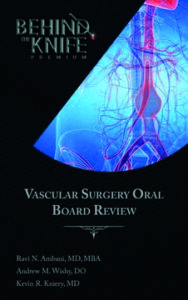
Think of it as the omega of the vascular surgical textbook literature, quips Andrew M. Wishy, DO. As a training resource, it fits neatly on the trainee bookshelf on one side—the end to a partner title, The Vascular Surgery Review Book, the alpha, or the beginning, on the other.
He is referring to Vascular Surgery Oral Board Review: Behind The Knife Premium, a textbook aimed at vascular surgery trainees taking the Vascular Surgery Board (VSB) Certifying Exam (CE), a work he helped craft and publish last year alongside colleagues Ravi N. Ambani, MD, and Kevin R. Kniery, MD, the latter known as a founder of popular surgical podcasts, Behind the Knife and Audible Bleeding.
Like the author of The Vascular Surgery Review Book, Wishy, Ambani and Kniery produced their title to provide a training resource and help fill a void they identified as they made their way through their own training. The idea germinated as they studied together to take the VSB CE, realizing there was a lack of available material with which to prepare.
“Both Ravi and Kevin were general surgeons first and had been through the oral board before in the general surgery realm,” explains Wishy, who, in contrast, completed his training under the integrated vascular surgery residency pathway. “We always practiced and tried to simulate these kinds of things for the integrated resident like me in our training institution: How is this really going to go? How is the back and forth going to be between the examiner and examinee? What kind of information are they going to want me to know? What’s too much? What’s not enough?”

As the CE preparation process was new to Wishy, that made him the perfect foil as the trio fine-tuned exactly what the textbook required. The ensuing text is comprehensive, he says.
“From cover to cover, you’re probably going to hit every high-yield topic there is [in vascular surgery], with every most-common procedure performed, and I would say the most common complications that I’ve ever ran into in practice, in the textbooks or heard from other people,” Wishy continues. “It’s not an all-inclusive resource by any means, but I think it’s a very good starting point, and covers the whole breadth of all the major and minor topics.”
The book has already proven a success among trainees since it was published last year, explains Ambani. “The three of us were able to pass our boards on the first attempt, and once we had the proof of concept that we did well, and now that we’re all Board-certified vascular surgeons, we thought it was best to get the cases and material we used down on paper, and get it published,” he says. “After this last round of oral boards, a bunch of people messaged to say that this was the only thing they used, and that they were successful and passed.”
Ambani reckons the two reference titles—their Vascular Surgery Oral Board Review: Behind The Knife Premium and Creeden’s The Vascular Surgery Review Book—meet vascular surgery at a crucial juncture. “Vascular surgery as a group is growing,” he says. “It’s becoming one of the most competitive specialties to match into after general surgery and after medical school, so the volume of trainees keeps going up and the interest keeps peaking. We have our own boards, so it’s time for us to develop resources to help people study for those specialty boards. The resources that exist currently are aimed at general surgery as a whole.”
The textbook tandem is “like a one-two punch,” Ambani adds. The Vascular Surgery Review Book plugs a hole for those preparing for the Vascular Surgery In-Training Exam (VSITE) and the VSB Qualifying Exam, while Vascular Surgery Oral Board Review: Behind The Knife Premium slots into the oral boards, or CE, realm. “Together, they are synergistic. They both came out a couple of months apart. These both are super useful in different ways, and together relatively low-cost resources for trainees that get them through their entire training—and hopefully through their boards.”












